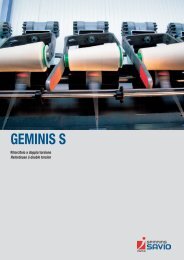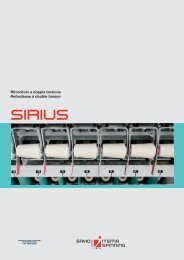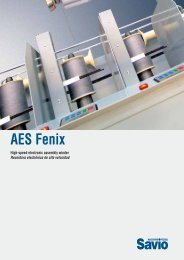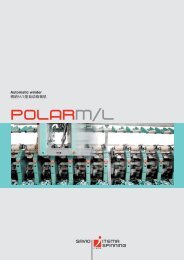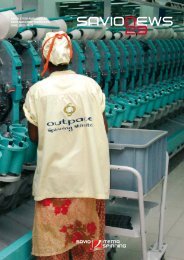Basyazıcıoglu Textile “Three ingredients of a successful company ...
Basyazıcıoglu Textile “Three ingredients of a successful company ...
Basyazıcıoglu Textile “Three ingredients of a successful company ...
You also want an ePaper? Increase the reach of your titles
YUMPU automatically turns print PDFs into web optimized ePapers that Google loves.
8 SAVIONEWS<br />
9<br />
SAVIONEWS<br />
POLAR/I - Direct Link System<br />
In the winding segment, process development and innovations have been always dictated by the needs expressed by the<br />
world market. In order to provide an answer to the market requirements, Savio introduced the POLAR automatic winder,<br />
available in a number <strong>of</strong> versions: the M/L with manual bobbin feeding and manual/automatic package d<strong>of</strong>fing, and the E/I<br />
designed as a stand-alone machine or for direct linkage with spinning machine.<br />
The many configurations available make POLAR the ideal patner for the winding process.<br />
MAIN FEATURES<br />
The main features <strong>of</strong> the new model POLAR/I DLS (Direct Link<br />
System) include the uninterrupted movement <strong>of</strong> the bobbin from<br />
the ring spinning frame to the winder. The machine is equipped<br />
with a newly designed yarn-end finder station aimed to increase<br />
the machine efficiency.<br />
This device can be combined with additional second and third<br />
station in order to match the production <strong>of</strong> the longest ring frames.<br />
The winding path has been modified, as regards the position <strong>of</strong><br />
the bobbin which is vertical; n° two bobbins as spares are present<br />
in each position.<br />
Particular attention has also been paid to the suction system,<br />
which is the most energy consuming component <strong>of</strong> a winding<br />
machine.<br />
A special fan, featuring high aerodynamic performance blades and<br />
a direct drive motor, minimizes energy consumption.<br />
The motor is controlled by the machine’s PC via an inverter, which<br />
automatically adjusts its speed to the real process conditions and<br />
settings.<br />
All lints are picked up in a collector box with dedicated filter placed<br />
on the machine’s headstock.<br />
The same suction system discharges the dust from the travelling<br />
blower into another dust box with different filter.<br />
SAVIO QUALITY<br />
The CAT system (Computer Aided<br />
Tension) online controls the<br />
tension <strong>of</strong> the yarn. The winding<br />
tension is continuously measured<br />
by the piezoelectric Tensor device<br />
which interacts with the yarn tensioner<br />
via the machine’s PC and<br />
modifies the load on the yarn in<br />
order to keep the winding tension<br />
constant during the whole bobbin<br />
unwinding stage.<br />
This control does not require<br />
continuous contact between the<br />
yarn and the sensor.<br />
The Tensor device, located just<br />
before the package, measures<br />
the actual winding tension, acts<br />
as an anti-wrap system and is<br />
maintenance free.<br />
The package quality is ensured<br />
by electronic on-<strong>of</strong>f system antiribonning<br />
device which operates<br />
only at the critical diameters.<br />
Upon request, a new intelligent<br />
Savio Bobbin Identification<br />
System enables the detection<br />
<strong>of</strong> the ring frame spindle which<br />
produces faulty bobbins. As<br />
additional feature, this system<br />
can be equipped with a centralized<br />
station which will automatically<br />
remove the faulty yarn from<br />
the detected faulty bobbin. In<br />
addition, important features are<br />
available depending on yarn type<br />
and downstream process <strong>of</strong> the<br />
packages. For coarse cotton<br />
carded yarn count, each single<br />
winding position can also be<br />
equipped with a dust removal<br />
unit, located at the level <strong>of</strong> the<br />
balloon breaker, in order to catch<br />
all fibrils and dust generated during<br />
the bobbin unwinding stage.<br />
The necessary vacuum is created<br />
by an independent fan serving<br />
two sections. The dust is discharged<br />
in another collector box with<br />
separate filter.<br />
The CAP system (Computer<br />
Aided Package) controls the<br />
yarn deposit on the package,<br />
in order to eliminate patterning<br />
defects and optimise downstream<br />
processes, mainly used<br />
for wool and delicate yarns.<br />
The yarn layering is controlled<br />
through the variation <strong>of</strong> the<br />
drum-package speed ratio,<br />
every time a critical diameter is<br />
reached. A special step motor<br />
modifies the drum-package position<br />
in order to ensure that the<br />
relative distance <strong>of</strong> the wound<br />
coils is maintained.<br />
Finally, the CAM system<br />
(Computer Aided Metering)<br />
ensures accurately the yarn<br />
length on the package. The<br />
request for a reduction in yarn<br />
remnants in a downstream<br />
processes, requires that the<br />
packages produced contain an<br />
extremely precise yarn length.<br />
The resulting savings are<br />
particularly welcome in case<br />
<strong>of</strong> added value yarns, such as<br />
wool, cashmere and silk. The<br />
combination <strong>of</strong> the laser detector<br />
with the package and drum<br />
sensors is managed by the<br />
machine’s PC. This measuring<br />
system is totally independent <strong>of</strong><br />
the yarn structure, shape, evenness<br />
and hairiness.



